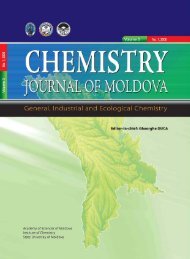stiinte med 1 2012.indd - Academia de ÅtiinÅ£e a Moldovei
stiinte med 1 2012.indd - Academia de ÅtiinÅ£e a Moldovei
stiinte med 1 2012.indd - Academia de ÅtiinÅ£e a Moldovei
Create successful ePaper yourself
Turn your PDF publications into a flip-book with our unique Google optimized e-Paper software.
176<br />
5. Solomon S., Verme A., et al., Effect of intensive versus<br />
standard blood pressure lowering an diastolic function<br />
in patients with uncontrolled hypertension and diastolic<br />
dysfunction. Hypertens., 2010; 55:241-249.<br />
6. Sebastiano Sciarreta., F. Paneni et al., Role of the<br />
renin-angiotensin-aldosterone system and infl ammatory<br />
process in the <strong>de</strong>velopment and progression of diastolic<br />
dysfunction. Clinical Science, 2009; 116: 467-477.<br />
7. Bella J.N., Palmieri V.,Roman M.J. et al., Mitral ratio<br />
of peak early to late diastolic fi lling velocity as a predictor<br />
of mortality in middle-aged and el<strong>de</strong>rly adults:The<br />
Strong Heart Study. Circulation, 2002; 105: 1928-1933.<br />
8. Kowalska I., Prokop J. et al., Disturbances of glucose<br />
metabolism in men reffered for coronary arteriography.<br />
Postload glycemia as predictor for coronary atherosclerosis.<br />
Diabetes Care, 2001; 24:897-901.<br />
9. Sower JR., Insulin resistance and hypertension. Am.<br />
J. Physiol. Heart Circ. Physiol., 2004; 286: H1597-1602.<br />
10. Müller-Brunotte R., Kahan T., Lopey B. Myocardial<br />
fi brosis and diastolic dysfunction in patients with hypertension:<br />
results from Swedish Irbesartan Left Ventricular<br />
Hypertrophy Investigation versus Atenolol (SILVHIA). J.<br />
Hypertens., 2007; 25:1958-1966.<br />
11. Solomon S.D., Janardhanan R. et al., Effect of angiotensin<br />
receptor blocka<strong>de</strong> and antihypertensive drugs on<br />
diastolic function in patients with hypertension and diastolic<br />
dysfunction: a randomised trial. Lancet, 2007; 2079-<br />
2087.<br />
12. Wachtell K., Bella J. et al., Change in diastolic<br />
left ventricular fi lling after one year of antihypertensive<br />
treatment. The Losartan Intervention For Endpoint Reduction<br />
in Hypertension (LIFE). Study Circulation, 2002;<br />
105:1071-1076.<br />
13.Ogihora T., Asono T., Ando K. et al., Angiotensin<br />
II induced insulin resistance is associated with enhanced<br />
insulin signaling. Hypertension, 2002; 40: 872-879.<br />
14. Theodore W. Kutz, Michael Pravenec., Antidiabetic<br />
mechanisms of angiotensin-converting- enzyme inhibitors<br />
and angiotensin II receptor antagonists: beyond the<br />
renin-angiotensin system. Journal of Hypertenesion, 2004;<br />
22: 2253-2261.<br />
Rezumat<br />
Studiul a evaluat influenţa <strong>med</strong>icaţiei <strong>de</strong> durată cu inhibitorul<br />
enzimei <strong>de</strong> conversie (ramipril) şi antagonistul<br />
receptorilor <strong>de</strong> angiotensină II (Eprosartan) asupra funcţiei<br />
diastolice şi insulinorezistenţei. Au fost cercetaţi 91 <strong>de</strong> pacienţi<br />
cu disfuncţie diastolică (confirmată ecocardiografic)<br />
şi hipertensiune arterială gr. II-III. După 12 luni <strong>de</strong> tratament,<br />
ambele re<strong>med</strong>ii au îmbunătăţit parametrii ecocardiografici<br />
ai fluxului transmitral şi indicii insulinorezistenţei<br />
(indicele HOMA IR<br />
), dar mai conclu<strong>de</strong>nt la administrarea<br />
eprosartanului.<br />
Summary<br />
The aim of the study was the influence of Ramipril<br />
and Eprosartan on diastolic function and insulin resistance.<br />
There were inclu<strong>de</strong>d 91 patients with diastolic dysfunction<br />
(confir<strong>med</strong> by Echocardiography) and hypertension II-III<br />
Buletinul AŞM<br />
<strong>de</strong>gree. After 12 months of treatment, both drugs improved<br />
transmitral flow parameters and HOMA IR<br />
in<strong>de</strong>x, but<br />
Eprosartan had a superior efficacy.<br />
Резюме<br />
Целью исследования было изучение влияния длительной<br />
терапии рамиприлом и эпросартаном на диастолическую<br />
функцию и инсулинорезистентность. В<br />
исследование были включены 91 больной с диастолической<br />
дисфункцией (эхокардиографически документированной)<br />
и гипертонической болезнью II–III степени.<br />
После 12 месяцев лечения оба препарата улучшили<br />
эхокардиографические параметры трансмитрального<br />
потока и показатели инсулинорезистентности (индекса<br />
НОМА), но с большим приемуществом при приеме<br />
эпросартана.<br />
EFECTELE CARDIOVASCULARE<br />
ALE INSULINEI<br />
__________________________________________<br />
Svetlana Protopop, dr. în <strong>med</strong>icină, conf. univ.,<br />
Leonid Lîsîi, dr. hab. în <strong>med</strong>icină, prof. univ.,<br />
Tatiana Cucu, stu<strong>de</strong>ntă, Doina Gangur, stu<strong>de</strong>ntă,<br />
USMF „Nicolae Testemiţanu”<br />
Introducere<br />
Una dintre cele mai importante şi distincte acţiuni<br />
biologice ale insulinei este stimularea transportului<br />
<strong>de</strong> glucoză în muşchii scheletici şi în ţesutul adipos.<br />
Celulele endoteliului vascular posedă o sensibilitate<br />
redusă faţă <strong>de</strong> insulină în ceea ce priveşte asimilarea<br />
glucozei, <strong>de</strong>oarece ele nu exprimă transportorul <strong>de</strong><br />
glucoză sensibil la insulină – GLUT4. Cu toate acestea,<br />
prin efectele vasodilatatoare <strong>de</strong>pen<strong>de</strong>nte <strong>de</strong> oxidul<br />
nitric (NO), produs <strong>de</strong> endoteliul vascular, insulina<br />
poate contribui la asigurarea cu glucoză a muşchilor<br />
scheletici şi a altor ţesuturi cu cerinţe metabolice<br />
înalte. Valorile fiziologice ale insulinei <strong>de</strong>termină o<br />
creştere a fluxului <strong>de</strong> sânge în membre, comparabilă<br />
în timp cu asimilarea glucozei <strong>de</strong> ţesuturile insulino<strong>de</strong>pen<strong>de</strong>nte.<br />
Este surprinzător faptul că <strong>med</strong>icamentele antidiabetice<br />
(<strong>de</strong> exemplu, troglitazonul), pe lângă ameliorarea<br />
sensibilităţii la insulină, micşorează şi tensiunea<br />
arterială. În plus, şoarecii transgenici insulinorezistenţi,<br />
datorită prezenţei alelelor nule ale genei IRS-1<br />
(insulin receptor substrate-1), sunt hipertensivi. Cele<br />
expuse susţin ipoteza că insulina reglează metabolismul<br />
glucozei şi circulaţia sangvină într-un mod inter<strong>de</strong>pen<strong>de</strong>nt,<br />
iar endoteliul vascular reprezintă, un<br />
ţesut-ţintă important pentru insulină, contribuind la<br />
cuplarea homeostazei metabolice şi hemodinamice

















